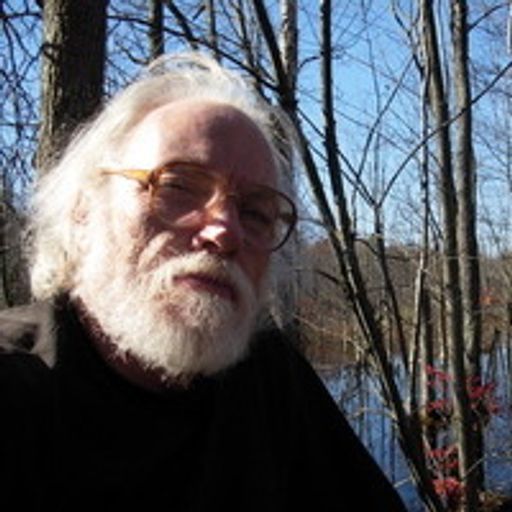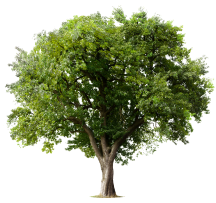James M. Hardesty
(1945 - June 9, 2021)
My brother, Kenneth Corum, and I first met Jim Hardesty while walking across the campus at Colorado College in Colorado Springs, Colorado in 1986. Asher Durand was a famous painter of the Hudson River group. If you’ve ever seen Durand‘s famous “Kindred Spirits” (shown below), an 1849 painting of Thomas Cole and William Cullen Bryant on the precipice of a gorge in the Catskill Mountains, then you know what I’ll be speaking about.
Jim spoke enthusiastically of Benjamin Franklin, Michael Faraday, Joseph Henry, Sir William Crookes, Oliver Lodge, Heinrich Hertz, Nikola Tesla, Niels Bohr, and Edwin Armstrong as if they were familiar old friends … and why not? Jim had spent a lifetime consuming everything they had ever written, and carefully replicating their apparatus and experiments! He knew instinctively what they were speaking about--whether it was the arcane hue of glowing Crookes tubes or the sound of threshold oscillations in Armstrong’s regenerative receivers. (Jim even telephoned me from Bear’s Den, the site of Mahlon Loomis’ 1872 radio transmissions.) Jim knew how to coax the last bit of astonishing performance from these mysterious and epic-making historic pieces of scientific equipment, built by the guidance of these giants with Jim’s own hands.
Yet Jim was an artist in the true sense of the word. He served as Resident Artist at Cornell’s Herbert F. Johnson Museum of Art, where he offered many programs in Chinese Painting and Calligraphy. Five of his paintings are included in Cornell’s permanent collection of Asian art. He also taught the art of Chinese calligraphy to students in the Department of Asian Studies, where his calligraphy is used as a logo for Cornell’s Intensive Mandarin Program.
Jim has been mystically (and correctly) described as a “time traveler.” (The appellation is due to H.G. Wells’ story, The Time Machine.) Jim traveled the far reaches of this planet and examined its distant cultures face-to-face. Whether reveling in his discoveries in the crypts of the British Museum in London and the Vatican, or his experiences in German science, his time in Russia, or his stay in Nepal where he learned to play the sitar and tabla within view of Mount Everest, it was enchantment! He spoke German, Russian, various dialects from India, and Mandarin Chinese, of course. I was with him on several occasions where native Chinese told him, “You speak Chinese better than me!”
But it was as a tool-maker and magician of science that he really shined. His research investigations on high-voltage Trichel pulses and the Madelun hysteresis loop in nonlinear magnetic detectors were demonstrated before the CIA, NSA, DIA and DARPA at a Top-Secret Lab facility in Warrenton, Virginia, and, later, before a roomful of dumbfounded scientific prima donnas (known as the JASON’s) at a “beyond Top-Secret” SKIF in La Jolla, California. Few people will understand this, but Jim was truly one of those ‘National Treasures’ that our Republic so desperately needs in this hour of National distress.
His technical curiosity was unlimited, and his natural wonder was boundless.
We also shared a common fascination with science fiction: The Time Machine and The day the Earth Stood Still were among our favorites. “Klaatu barada nikto” (which someone translated as, "I die, repair me, do not retaliate"). Theremin music rouses the novel enchantment of the movie. Jim saw the film in the 1950’s; I never saw it until a few years ago. My boyhood memories are from listening in bed to a 1954 radio program on a crystal set (Lux Radio Theater, January 1954.) I have to share one scene that Jim and I hooted over many times, because it was meant to be serious, and it bore such significance to our lives’ research.
In the scene young Bobby Bensen and Klaatu (the space man) go to visit Professor Barnhardt, the world’s greatest philosopher and thinker. (He’s a thinly veiled caricature of Albert Einstein, of course.) Einstein’s not home, but there is an unsolved problem in celestial mechanics written on the blackboard in Einstein’s study. (Mercury’s perihelion precession?) Klaatu scribbles some calculations on the board and they leave.
In the next scene, Einstein is standing in front of the blackboard, completely baffled, hair askew … totally stumped. Einstein doesn’t have a clue. (‘Ich been Kaput.’) Klaatu appears, and tells him, “Differentiate the equation and solve it by ‘variation of parameters.’” Einstein pounds his head and says, “Ah … Of course!”
Now, back in the ‘50’s when Jim Hardesty and I were youngsters, “variation of parameters” was mystical sci-fi talk. It must really be deep mathematics that only brainy scientists can do . . . .
That haunting phrase was something that stayed with both of us on up to our college years as a mystery. What a let-down when, as physics and engineering sophomores taking a course in ordinary differential equations, we found out how trivial it actually is. (When you excite a linear differential equation with its eigenfunction you get repeated roots … it’s called mathematical resonance … not exactly the same as tuning to electrical resonance because of damping. But it turned out to be the key to launching Zenneck waves!)
The mystery of the Great Pyramid and its inner chambers was always a constant topic of conversation, and more recently, the enigmatic Djed, which is displayed on several hieroglyphic panels. (Jim had explored the interior of the Great Pyramid during a summer semester near Cairo, not far from the banks of the Nile.)
Ken and I had the privilege of engaging his prolific Renaissance intellect for 35 years of conversation and experimental investigations. Benjamin Franklin – Mahlon Loomis – Nikola Tesla: Jim occupied a unique time in the chronicle of electro-science history: there will never be another Jim Hardesty.
“Deep calleth unto deep” (Psalm 42:7)
C.S. Lewis, prolific writer, professor at both Oxford and Cambridge, member of The Inklings, author of The Oxford History of English Literature, once spoke of something called “Sehnsucht.” He described it this way in his 1938 book, The Problem of Pain,
“All the things that have deeply possessed your soul have been but hints of it (Shensucht) – these tantalizing glimpses, promises never quite fulfilled, echoes that died away just as they caught your ear. We cannot tell each other about it. It is the secret signature of each soul, the incommunicable and unappeasable want . . . which we shall still desire on our deathbeds . . .”
Sehnsucht is that nameless longing which God has embedded deep within the human heart.
“The books or the music in which we thought the beauty was located will betray us if we trust to them; it was not in them, it only came through them, and what came through them was longing.” [C.S. Lewis, The Weight of Glory, 1942]
400 years ago, when Johannes Kepler was carefully analyzing planetary motion in the starry heavens (from Tycho’s data taken at the Uraniborg on Hven) and distilling the three laws that, years later, opened the pathway for Isaac Newton to unlock universal gravitation, Kepler wrote (note the unusual words Kepler uses),
“I give thanks to You, Lord Creator, because You have lured me into the enjoyment of Your work.” (Johannes Kepler, 1618)
Jim and I were driving up to a Physics Symposium where we were to give a radio-physics lecture at Syracuse University several years ago, and the topic of religion and the afterlife came up in our conversation. Jim felt deeply about Tao, living in harmony and the Chinese notion of “the Way.” He turned to me and asked, “Jim, you’ve studied Physics, Mathematics, Astronomy and Cosmology, Electro-Science, and everything Tesla ever wrote . . . What’s the purpose behind it all?
Somewhat puzzled, I blurted out the first passage from the old Westminster Confession.
Jim pressed for more. “Yes, but . . . what do you really believe?”
I thought for a moment and replied with those celebrated lines from the Apostle’s Creed:
“I believe in God the Father Almighty,
Maker of heaven and earth . . .”
And, without missing a beat, Jim chimed right in with,
“And in Jesus Christ his only Son our Lord,
Who was conceived by the Holy Ghost,
Born of the Virgin Mary,
Suffered under Pontius Pilate,
Was crucified, died, and was buried:
He descended into hell;
The third day he rose again from the dead;
He ascended into heaven,
And sitteth on the right hand of God the Father Almighty;
From thence he shall come to judge the living and the dead.”
And then, together (as truly “kindred spirits”) we finished in unison,
“I believe in the Holy Ghost;
The holy catholic Church;
The Communion of Saints;
The Forgiveness of sins;
The Resurrection of the body,
And Life everlasting . . . Amen.”
In scripture Jesus said,
“I am the resurrection and the life: He that believeth in me, though he were dead, yet shall he live: And whosoever liveth and believeth in me shall never die.” (John 11:25-26)
In the final chapters of the Bible we read those beautiful words of Saint John the Revelator, written while exiled on the Isle of Patmos (note Handel’s comment about the Messiah: “I saw heaven open before me….”),
1) And I saw a new heaven and a new earth: for the first heaven and the first earth were passed away; and there was no more sea.
2) And I, John, saw the holy city, new Jerusalem, coming down from God out of heaven, prepared as a bride adorned for her husband.
3) And I heard a great voice out of heaven saying, Behold, the tabernacle of God is with men, and he will dwell with them, and they shall be his people, and God himself shall be with them, and be their God.
4) And God shall wipe away all tears from their eyes; and there shall be no more death, neither sorrow, nor crying, neither shall there be any more pain: for the former things are passed away.
5) And he that sat upon the throne said, Behold, I make all things new. And he said unto me, Write: for these words are true and faithful. [Revelation, Chapter 21]
Our hearts go out to his wife, Judy, who must now finish her work and life’s journey without Jim physically at her side. Yet, we recall lines from Albert Kennedy Roswell’s poem, “Should You Go First”:
Should you go first and I remain,
To walk the road alone,
I'll live in memory's garden, dear,
With happy days we've known.
We've known so much of happiness,
We've had our cup of joy,
And memory is one gift of God
That death cannot destroy.
“Kindred Spirits” (Thomas Cole and William Cullen Bryant in the beautiful Catskill mountains), painted by Asher B. Durand (1849). Cole is known as the Father of the Hudson River School of artists. Both Cole and Durand were students of artist Samuel F. B. Morse, several years before Morse invented the telegraphy and Morse code.
Dr. James F. Corum & Linda L. Corum, Morgantown, West Virginia, June 2021
APPENDIX: PROFESSIONAL BIOSKETCH
James M. Hardesty (b. 1945, Philadelphia, PA) held a B.A. in German and Russian Languages and Literature from LaSalle College (1967), an M.A.T. in Asian Studies/Education, Chinese Language from Seton Hall University (1969), and spent three years in the Chinese Art and Archeology Ph.D. program of Princeton University (1969-72). His other interests during this time were the history of the physics of electricity and magnetism, astrophysics, and wireless technology. During some of this time, Mr. Hardesty taught courses in the German and Chinese languages.
After leaving Princeton, Mr. Hardesty traveled extensively overseas, visiting many scholars, art collectors, art and science museums, and archeological sites. After his return, he settled in the Ithaca, New York area, and later spent a year in Taipei, Taiwan, furthering his practice of Chinese painting and calligraphy, sealstone carving, and scroll mounting, under masters in those respective arts. Upon his return to the Ithaca area, he established Dancing Brush Chinese Painting Studio and PV Scientific Instruments, two firms that offer educational programming and artisan-crafted items to a variety of clients. Among these clients was Cornell University, where Mr. Hardesty taught courses in Chinese painting and Chinese calligraphy for the Johnson Art Museum, the Asian Studies Department, the East Asia Program, and the Bailey Hortorium. Mr. Hardesty’s Chinese calligraphy and artworks reside in many collections, including the permanent Asian Art collection of Cornell’s Johnson Museum.
At Cornell he also taught the practical building, use, and science historical implications of classical scientific apparatus for the School of Electrical and Computer Engineering, the Department of Materials Science and Engineering, and the Physics Department. Through various departments of Cornell University, Mr. Hardesty provided outreach programs to educational institutions throughout New York State.
Through his firm, PV Scientific Instruments, Mr. Hardesty also presented lecture/demonstrations on the scientific histories of the x-ray and wireless and taught credit courses on the physics of radiologic technology at teaching hospitals and other educational venues throughout the Northeastern United States.
Mr. Hardesty is was an internationally distinguished scientific instrument maker who specialized in reproducing apparatus used in great discoveries in electricity, magnetism, wireless, and atomic physics. In this capacity, he built hundreds of reproductions of period regenerative radios made with original parts (his most popular instruments) and hundreds more pieces of classical wireless apparatus. He also supplied major museums, educational institutions, the entertainment industry, the research industry, and private collectors with working reproductions of apparatus used by Benjamin Franklin, Mahlon Loomis, Nikola Tesla, Oliver Lodge, Heinrich Hertz, James Wimshurst, William Crookes, Wilhelm Conrad Roentgen, and many other pioneers. These institutions include (to name a few) The Franklin Institute, the San Francisco National Maritime Museum, and the Chicago Museum of Science and Industry.
In his capacity as instrument maker, Mr. Hardesty lectured and demonstrated his scientific instruments at the National Academy of Sciences, the American Philosophical Society, and the American Society of Radiologic Technologists. Instruments built by him have been used in a number of stage, screen, and television productions, including in Birmingham, AL; Hollywood, CA; Rome, Italy, and the PBS Network TV-documentary, Tesla: Master of Lightning, produced and directed by Emmy Award winner, Robert Uth. In addition to a number of papers published in the scientific literature, Mr. Hardesty’s publications include video productions on various subjects in x-ray and vacuum tube technologies and several elementary textbooks on topics of electricity, magnetism, and invention.
Mr. Hardesty served as a technical consultant to National Electrodynamics, where his research investigations were demonstrated before the CIA, NSA, DIA and DARPA at the Warrenton, VA Test Facility and the JASON’s in La Jolla, CA. In recent years, his major research focus has been the history and development of regenerative detectors. Along with his wife, Judith Hardesty, James F. Corum, and Kenneth Corum, his most recent research also involved producing an extensive professional biography of Mahlon Loomis, documenting Loomis’ 19th-century RF technology, which bridges the gap between Benjamin Franklin and Heinrich Hertz.
Jim will be remembered as a master painter and calligrapher in the Chinese tradition, an internationally recognized electrical historian and instrument maker, a critical thinker and strategic planner able to evaluate options in light of objectives and operations, an outstanding writer and communicator, an enthusiastic public speaker, and an inspiring teacher.
To send a flower arrangement or to plant trees in memory of James M. Hardesty, please click here to visit our Sympathy Store .
To order memorial trees or send flowers to the family in memory of James M. Hardesty, please visit our flower store.





